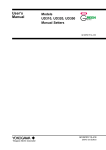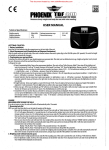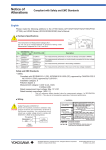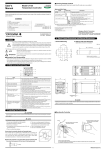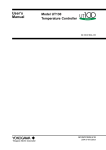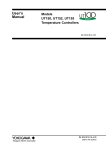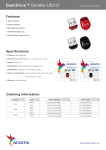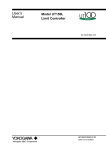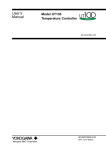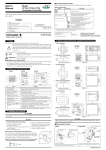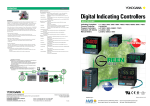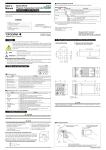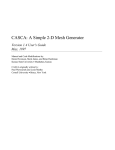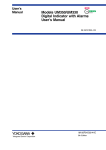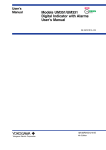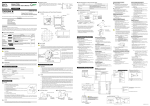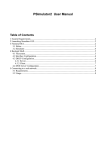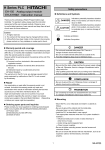Download User`s Manual
Transcript
■ Checking Package Contents User’s Manual Before using the product, check that its model & suffix codes are as you ordered. Models UD310/UD320/UD350 Manual Setters Model and Suffix Codes Suffix code Model UD310 UD320 UD350 –0 Fixed code Please read through this user's manual to ensure correct usage of the manual setter and keep it handy for quick reference. Description UD310 Manual Setter 4 to 20 mADC output (48⫻48⫻100 mm) UD320 Manual Setter 4 to 20 mADC output (48⫻96⫻100 mm) UD350 Manual Setter 4 to 20 mADC output (96⫻96⫻100 mm) Always 0 0 Fixed code Option Always 0 /V24 Power Supply 24V DC / 24V AC * 2 Alarm outputs and PV retransmission output in 4 to 20 mA built in as standard. Contents 1. 2. 3. 4. 5. 6. 7. 8. Notice ........................................................... What is on the Front Panel? ................................. Installing the Manual Setter ................................. Panel Cutout Dimensions and External Dimensions ..... Wiring .......................................................... Hardware Specifications ..................................... Key Operations ................................................ Troubleshooting ............................................... 1 1 1 1 2 2 3 3 Check the package contents against the list below. • Manual Setter ..................................... 1 • Mounting bracket ................................ 1 for UD310 2 for UD320, UD350 • User's manual (this manual) .................... 1 Revision Record IM 05F01F12-01E 1st Edition: Feb. ’01 2nd Edition: Jun. ’04 IM 05F01F12-01E Jun. 2004 2nd Edition 1. Notice 4. Panel Cutout Dimensions and External Dimensions The following safety symbol is used both on the product and in this user's manual. This symbol stands for “Handle with Care.” When displayed on the product, the operator should refer to the corresponding explanation given in the user's manual in order to avoid injury or death of personnel and/or damage to the product. In the manual the symbol is accompanied by an explanation of the special care that is required to avoid shock or other dangers that may result in injury or loss of life. 1. General Mounting Draws attention to information that is essential for understanding the operation and/or features of the product. 45 +0.6 0 max. 44.8 48 12 100 45 +0.6 0 ■ Exemption from Responsibility Make sure that all of the precautions are strictly adhered to. Yokogawa Electric Corporation assumes no liability for any damage resulting from use of the instrument in contradiction to the precautions. Also, Yokogawa Electric Corporation assumes no liability to any party for any loss or damage, direct or indirect, caused by the use or any unpredictable defect of the instrument. max. 44.8 2. Side-by-side Close Mounting [(N –1) × 48 + 45] +0.6 0 48 IMPORTANT 25 UD310 N is the number of manual setters. If N > 5, then measure the actual length. max. 61 The following symbols are used in this manual only. Indicates that operating the hardware or software in a particular manner may lead to NOTE damage or result in system failure. Unit: mm 45 +0.6 0 min. 70 25 UD310 max. 47.8 min. 70 Panel thickness 1 to 10 1. General Mounting UD350 Unit: mm min. 145 a. a. b. c. b. b. d. 2. Side-by-side Close Mounting [(N –1) × 48 + 45] +0.6 0 d. ■ Monitoring Parts PV display (red) Indicates PV (measured value) and character information such as parameter codes and error codes. PV goes out when the setup parameter ”PVD” is set to OFF. b. SP display (green) Indicates SP (target setpoint) and character information such as parameter setpoints. c. AL1, AL2 lamps (red) AL1 : Lit when alarm 1 is activated. AL2 : Lit when alarm 2 is activated. UD350 Function • Changes SP(target setpoint) and the parameter setpoints. Pressing this key decreases the data value. SP (target setpoint) will be output in 3 seconds after the change. Holding down the key will gradually decrease the speed of changes. SET key • Registers the parameter setpoint changed using the data change keys. (parameter data registering key) • Switches between parameter setting displays sequentially. • Pressing the key for 3 seconds or longer in the operating display retrieves the operating parameter setting display. • Pressing the key for 3 seconds or longer in operating or setup parameter setting display transfers back to operating display. e. 92 +0 0.8 Data change key 53 min. 145 Unit: mm 25 92 100 11 96 + 0.8 0 2. Side-by-side Close Mounting [(N –1) × 96 + 92] +0.8 0 UD350 92 +0.8 0 3. Installing the Manual Setter CAUTION N is the number of manual setters. If N > 5, then measure the actual length. To prevent electric shock, the source of power to the manual setter must be turned off when mounting the manual setter on to a panel. NOTE 6. There are no resulting magnetic disturbances; 7. The terminal board (reference junction compensation element, etc.) is protected from wind; 8. There is no splashing of water; and 9. There are no flammable materials. Never place the manual setter directly on flammable items. If the manual setter has to be installed close to flammable items or equipment, be sure to enclose the manual setter in shielding panels positioned at least 150mm away from each side. These panels should be made of either 1.43mm thick metal-plated steel plates or 1.6mm thick uncoated steel plates. ● Mount the manual setter at an angle within 30° from horizontal with the screen facing upward. Do not mount it facing downward. Panel thickness 1 to 10 Splash-proof construction is not available when the side-by-side close mounting method shown in the above figure, is chosen for any of the manual setters. NOTE To install the manual setter, select a location where: 1. No-one may accidentally touch the terminals; 2. Mechanical vibrations are minimal; 3. Corrosive gas is minimal; 4. The temperature can be maintained at about 23°C with minimal fluctuation; 5. There is no direct heat radiation; max. 112 • Changes SP(target setpoint) and the parameter values. Pressing this key increases the data value. SP (target setpoint) will be output in 3 seconds after the change. Holding down the key will gradually increase the speed of changes. max. 91.8 min. 117 Name Data change key 1-1051-6041-5031-4021-3011-20 1. General Mounting ■ Operating Parts (See 7. Key operations) d. Panel thickness 1 to 10 N is the number of manual setters. If N > 5, then measure the actual length. max. 91.8 a. UD320 Function 92 +0.8 0 Name 45 +0.6 0 max. 91.8 25 e. 96 d. e. max. 112 UD350 UD320 e. 100 96 UD310 11 48 c. 92 +0.8 0 a. c. max. 44.6 UD320 UD320 53 UD310 1-1021-301-20 min. 70 2. What is on the Front Panel ? ■ Mounting the Manual Setter UD310 Large bracket (top) UD320, UD350 Panel 1. Affix the bracket over the back end of the manual setter. 2. Push the bracket to the panel, and then secure the bracket into position. Terminal board Panel 150mm Direction for mounting 150mm Insert a screwdriver into the brackets to tighten the screws. 150mm 150mm UD310 Bracket Small bracket (bottom) [ How to remove the bracket ] Insert the manual setter into the opening with the terminal board facing the front. To remove the bracket, push down the center of the upper and lower parts Set and tighten the top and bottom brackets on the manual setter to fix it on the panel. of the manual setter softly. The bracket is released from the latch. 30° (MAX) 1 IM05F01F12-01E 5. Wiring ● Cable Specifications and Recommended Products CAUTION 1) Before you start wiring, turn off the power source and use a tester to check that the instrument and cables are not receiving any power in order to prevent electric shock. 2) For safety, be sure to install a circuit breaker switch (of 5A and 100V AC or 220V AC, and that conforms to IEC60947) near the instrument so as to be operated easily, and clearly indicate that the device is used to deenergize the instrument. 3) Wiring should be carried out by personnel with appropriate electrical knowledge and experience. Power supply and relay contact output 600V vinyl insulated wire/cable, JIS C3307, 0.9 to 2.0mm2 Thermocouple input Shielded compensating lead wire, JIS C1610 RTD input Shielded wire (3-wire), UL2482 (Hitachi cable) Other signals Shielded wire ● Recommended Terminals Use M3.5 screw-compatible crimp-on terminals with an insulating sleeve, as shown below. NOTE 7mm or less ø 3.7mm 7mm or less ø 3.7mm 1) Use a single-phase power source. If the source has a lot of noise, use an isolation transformer for the primary side and a line filter (we recommend TDK’s ZAC2205-00U product) for the secondary side. When this noise-prevention measure is taken, keep the primary and secondary power cables well apart. Since the manual setter has no fuse, be sure to install a circuit breaker switch (of 5A and 100V AC or 220V AC, and that conforms to IEC standards) and clearly indicate that the device is used to de-energize the manual setter. 2) For thermocouple input, use shielded compensating lead wires. For RTD input, use shielded wires which have low resistance and no resistance difference between the 3 wires. See the table given later for the specifications of the cables and terminals and the recommended products. 3) The alarm output relay cannot be replaced even though it has a limited service life (100,000 relay contacts for the resistance load). Thus, an auxiliary relay should be used so that the load can be turned on and off. 4) When using an inductive load (L) such as an auxiliary relay and solenoid valve, be sure to insert a CR filter (for AC) or diode (for DC) in parallel as a spark-rejecting surge suppressor to prevent malfunctions or damage to the relay. 5) When there is the possibility of being struck by external lightening surge, use the arrester to protect the instrument. IMPORTANT Always fix a terminal cover bracket to the UD310 manual setter before wiring if an optional anti-electric-shock terminal cover (part number: L4000FB) is used. IMPORTANT Two types of optional anti-electric-shock terminal covers (part numbers T9115YE and T9115YD) are available for the UD320 and UD350 manual setters, respectively. Receiving 4-20 mA DC Current Signals with the Manual Setter ■ Model UD310-00 Terminal Arrangement NOTE Do not use unassigned terminals as relay terminals. 11 ALM2 12 ALM1 13 Universal input-selectable input type Measured Value (PV) Input Alarm Outputs RTD Input TC Input + 7 COM 8 – 6 B 7 b 8 A * When receiving 4-20 mA DC current signals, set the PV input type to 1-5 V DC (setpoint “22”). DC mV or V Input 7 + 8 – 7 + 250 Ω 4-20mA 8 PV Retransmission Output 1 + 2 – 4 to 20 mA DC Note: Connecting a 250 Ω resistor to the terminals is optional. Model: X010-250-2 (resistor with M3.5 crimp-on terminal lugs) 6 1 11 2 12 7 3 13 8 4 14 9 5 15 10 - Power Supply CAUTION L 9 + 9 AC/DC 24V 10 10 – N 100-240V AC when /V24 option is specifed. To prevent damage to the manual setter, never provide 100-240V AC power supply for power supply AC/DC 24V model (when ⬙/V24⬙ is specified). NOTE Manual Setting (SP) Output The + and – stand for the polarity for DC 24V power supply. 4 to 20 mA Output + 14 15 – ■ Models UD320-00/UD350-00 Terminal Arrangement Measured Value (PV) Input Note:The terminal arrangements of the UD320 and UD350 are the same. RTD Input TC Input 12 Receiving 4-20 mA DC Current Signals with the Manual Setter Universal input-selectable input type * When receiving 4-20 mA DC current signals, 11 B + set the PV input type to 1-5 V DC (setpoint “22”). DC mV or V Input 12 + 12 + 12 b 13 NOTE – 250 Ω 4-20mA 13 – 13 A 13 - Do not use unassigned terminals as relay terminals. 11 12 4 to 20 mA Output 13 14 14 PV Retransmission Output 29 + 4 to 20 mA DC 30 – 16 27 17 28 18 29 19 30 20 + Alarm Outputs 15 – 15 26 Note: Connecting a 250 Ω resistor to the terminals is optional. Model: X010-250-2 (resistor with M3.5 crimp-on terminal lugs) Manual Setting (SP) Output 16 ALM2 17 ALM1 18 COM CAUTION To prevent damage to the manual setter, never provide 100-240V AC power supply for power supply AC/DC 24V model (when ⬙/V24⬙ is specified). Power Supply 19 L 19 + NOTE AC/DC 24V 20 20 – N 100-240V AC when /V24 option is specifed. The + and – stand for the polarity for DC 24V power supply. 6. Hardware Specifications Measured Value (PV) Input 1 point • Input: type: Universal; can be selected by software • Input accuracy (at 23 ±2°C ambient temperature) • Input Thermocouple: ±2°C ±1digit • • • • • • • • • • However, • ±4°C for thermocouple input –200 to –100°C • ±3°C for thermocouple input –100 to 0°C • ±5°C for types R and S (±9°C for 0 to 500°C) • ±9°C for type B (accuracy is not guaranteed for 0 to 400°C) • RTD: ±1°C ±1digit •Voltage(mV, V) : ±0.3% ±1digit Sampling period for measured value input: 500ms Burn-out detection: Functions for thermocouple or RTD input (burn-out upscale only; cannot be switched off) Input resistance: 1MΩ or greater for thermocouple or DC mV input. Approx. 1MΩ for DC V input Maximum allowable signal source resistance : 250Ω for thermocouple or DC mV input 2kΩ for DC V input Maximum allowable wiring resistance for RTD input: 10Ω/wire (The resistance values of three wires must be the same.) Allowable input voltage: ±10V DC for thermocouple or DC mV input ±20V DC for DC V input Noise rejection ratio: Normal mode noise: Min. 40dB (50/60Hz) Common mode noise: Min. 120dB (Min. 90dB for DC V input) Error of reference junction compensation:±1.5°C (at 15-35°C) ±2.0°C (at 0-50°C) The reference junction compensation cannot be switched off. Applicable standards: Thermocouple and resistance temperature detector(RTD) JIS/IEC/DIN (ITS90) Alarm types: 22 types • (waiting action can be set by software): • Retransmission Output signal: Measured value in 4-20mA DC, • Output can be scaled. load resistance: 600Ω • Maximum Output accuracy: ±0.3% of span • (at 23±2°C ambient temperature) Manual Setting (SP) Output • • IM05F01F12-01E Power Supply and Isolation Compliant with IEC/EN61010-1: 2001, • Safety: approved by CSA1010, approved by UL508. PV high limit, PV low limit, Deviation high limit, Deviation low limit, De-energized on deviation high limit, De-energized on deviation low limit, Deviation high and low limits, Deviation within high and low limits, Deenergized on PV high limit, De-energized on PV low limit, Fault diagnosis output, FAIL output Alarm output: 2 relay contacts Relay contact capacity: 1A at 240V AC or 1A at 30V DC (with resistance load) (COM terminal is common) Note: The alarm output relays cannot be replaced by users. • Installation category : CAT. II (IEC/EN61010, CSA1010) Pollution degree : 2 (IEC/EN61010, CSA1010) Measurement category : I (CAT. I : IEC/EN61010) Rated measurement input voltage : 10V DC max.(across terminals), 300V AC max.(across ground) Rated transient overvoltage : 1500V (Note) Note : It is a value on the safety standard which is assumed by IEC/EN61010-1 in measurement category I, and is not the value which guarantees an apparatus performance. Caution: This equipment has Measurement category I, therefore do not use the equipment for measurements within measurement categories II, III and IV. EMC standards: Complies with EN61326. The instrument continues to operate at a measuring accuracy of within ±20% of the range during tests. Internal Wiring 3 Entrance 4 Cable Measurement category SP (target setpoint) will be output in 3 seconds after the change. Output: 1 point Output type: Current output Output signal: 4 to 20mA current output Maximum load resistance: 600Ω Output accuracy: ±0.3% of span (at 23±2°C ambient temperature) Safety and EMC Standards Alarm Functions ■ Alarm Functions Description 2 T Remarks 1 CAT.1 For measurements performed on circuits not directly connected to MAINS. 2 CAT.2 For measurements performed on circuits directly connected to the low voltage installation. Appliances, portable equipments, etc. 3 CAT.3 For measurements performed in the building installation. Distribution board, circuit breaker, etc. 4 CAT.4 For measurements performed at the source of the low-voltage installation. Overhead wire, cable systems, etc. 2 ■Power Supply Power supply Rated at 100-240VAC (±10%) AC/DC 24V, 20 to 29V of allowable range when ⬙/V24⬙ is specified. 50 or 60Hz Voltage Frequency Maximum power consumption Memory Withstanding Between primary terminals and secondary terminals voltage (See Notes 1 and 2.) Insulation Between primary terminals resistance and secondary terminals (See Notes 1 and 2.) 8VA max. (4W max.) 3W max. when ⬙/V24⬙ is specified. Non-volatile memory 1500V AC for 1 minute ■ Isolation The bold lines below indicate reinforced isolation, and the broken line indicates functional isolation. Power supply Power supply terminals AC/DC 24V terminals (When ⬙/V24⬙ is specified) (100-240V AC) Measured value input terminals Internal circuit Alarm output Manual setting output terminals terminals : 4-20 mA (2 relay contacts) Retransmission output terminals : 4-20 mA Note: The measured value input terminals is isolated from the internal circuit. • • • • • • • • • • • IP55 [Models UD320 and UD350]. For side-by-side close installation the controller loses its dust-proof and drip-proof protection. Casing: ABS resin and polycarbonate Case color: Black Weight: UD310 - approx. 200g UD320 - approx. 300g UD350 - approx. 400g Mounting: Flush panel mounting Wiring: Screw terminals Environmental Conditions 20MΩ or more at 500V DC Note 1: The primary terminals are the power supply terminals and alarm output terminals. The secondary terminals are the analog input and output terminals. Note 2: AC/DC 24V terminals are secondary terminals. • Construction, Mounting, and Wiring Construction: Dust-proof and drip-proof front • panel conforming to IP65 [Model UD310] and ■Normal Operating Conditions time: At least 30 minutes • Warm-up Ambient temperature:0-50°C (0-40°C when • mounted side-by-side) of change of temperature: 10°C/h or less • Rate humidity: 20-90% RH (no condensation allowed) • Ambient field: 400A/m or less • Magnetic vibrations of 5 to 14Hz: Amplitude of 1.2mm or less • Continuous Continuous vibrations 14 to 150Hz: 4.9m/s (0.5G) or less • Short-period vibrations:of14.7m/s for 15 seconds or less • Shock: 98m/s (10G) for 11(1.5G) milliseconds or less • Mounting angle: Upward incline up to 30 • degrees; downward incline is not ofallowed. Altitude: 2000m or less above sea level •■Maximum Effects from Operating Conditions 2 2 2 (1) Temperature effects Thermocouple, DC mV and DC V input: ±2µV/°C or ±0.02% of F.S./°C, whichever is larger Resistance temperature detector: ±0.05°C/°C Analog output: ±0.05% of F.S./°C (2) Effect from fluctuation of power supply voltage (within rated voltage range) Analog input: ±0.2µV/V or ±0.002% of F.S./V, whichever is larger Analog output: ±0.05% of F.S. /V • • • • •■Transportation and Storage Conditions –25 to 70°C • Temperature: 5 to 95% RH (no condensation allowed) • Humidity: Shock: Package drop height 90cm (when packed in • the dedicated package) 7. Key Operations IMPORTANT CAUTION The manual setter is shipped with the parameters set at the factory-set defaults. Check the default values against the “Parameter Lists” in the following page, and change the parameter setpoints that need to be changed. To prevent electric shock, the manual setter should be mounted on the panel so as not to accidentally touch the terminals when power is being applied. (1) You can move between parameter setting displays using the (2) To change the parameter setpoint, ( i ) Change the display value with the (ii) Press the or This section explains how to set and register parameter setpoints. The procedure for changing Target Setpoint(SP) and Alarm 1 Setpoint(A1) can be found on "Changing Target Setpoint(SP)" and "Changing Alarm 1 Setpoint(A1)". You can set the other parameters in the same way. key. key (the period flashes). ■ Changing Target Setpoint (SP) key to register the setpoint. (3) In the operating display, pressing the Check alarm type before setting the alarm setpoint. Factory-set settings: Alarm 1 type : OFF Alarm 2 type : OFF The following instructions assume that the manual setter is already receiving power. SP (target setpoint) value will be output in 3 seconds after the change. key for at least 3 seconds retrieves the operating parameter setting display. (4) In the operating parameter setting display, pressing the ■ Changing Alarm 1 Setpoint (A1) key for at least 3 seconds transfers back to the oper- ating display. Registering the key-lock parameter LOC to “–1” retrieves the setup parameter setting display. (5) In the setup parameter setting display, pressing the Step 1: Confirm that the manual setter shows the operating display during normal operation (PV and SP are displayed on the indicators). key for at least 3 seconds transfers back to the operating display. NOTE Changing certain setup parameters may automatically initialize the operating parameters. Therefore, after you change the setup parameters, always check the operating parameter setpoints to find out if appropriate values have been set for them. If the operating parameters have been initialized, set them to their appropriate values. NOTE then press the UD310 UD310 Step 2: To enter the operating parameter setting display, press the key for at least 3 seconds. Step 2: Press the or key to change the SP display value to the required setpoint. In this example, SP is changed to 200°C. At power-on, the manual setter displays the operating display, but if the measured input type setting remains OFF, “IN” appears. In this case, press the key to display the measured input range code you want to use, Step 1: Confirm that the manual setter shows the operating display during normal operation (PV and SP are displayed on the indicators). UD310 UD310 key to register it. (Refer to the flowchart below.) Press for at least 3 seconds. Power ON A Step 3: Press the or key to change the current A1 setpoint to a required setpoint. In this example, A1 is changed to 200°C. NOTE At first When measured input range code has been already set, the operating display shown below appears. No Yes is displayed ? Operating Display Minimum value of measured input range (scale) UD310 Maximum value of measured input range (scale) The period flashes while the setpoint is being changed. Measured input range Measured input value(PV) TIP Set the parameters as follows not to display a measured input value. No display Target setpoint(SP) Measured input type (IN): DC voltage input (20 to 23) Target setpoint(SP) UD310 UD310 When parameter PVD=ON (factory-set default) PV/SP display (PVD) : OFF When parameter PVD=OFF When “In” appears, press the key to display the measured input range code you want to use, then press the key to register it. After this operation, the manual setter shows the operating display. SPL SPH Target setpoint range (after scaling) 20mA 4mA Note Press the key for at least 3 seconds. (To operating display) Press the key for at least 3 seconds. SPH SPL Target setpoint range (Factory-shipped settings) Manual setting output (4 to 20mA) A Press the key for at least 3 seconds. (To operating display) Note Step 4: Press the key once to register the setpoint. The period goes out. A1 is now changed. Another press of the key calls up the Alarm 2 setpoint(A2) display. To return to the operating display, press the Note: If no key is pressed for a period of two minutes or more while in the operating or setup parameter setting display, the manual setter automatically returns to operating display. UD310 UD310 The period goes out. key for at least 3 seconds. 8. Troubleshooting In the event of an abnormality, perform the following checks as outlined by the flowchart. Is the manual setter defective? Yes Operating Parameter Setting Display Setup Parameter Setting Display No Completely inactive? Press the key IN to move between items. A1 A2 FL BS LOC LOC= • Displayed when AL1, AL2 = 1 to 20 When LOC=–1, transfers to the setup parameter setting display Press the key to move between items. Yes DP RH RL Check the terminal connection of the power supply Displayed when DC voltage input range code (20 to 23) is set NOTE Set ⬙-1⬙ to enter the setup parameter setting display. But if ⬙LOC=1 or 2⬙ is already set, the parameter value can not be changed by setting ⬙LOC=-1⬙ only. To change the parameter value, set ⬙LOC=0⬙ at first (for disabling keylock), then set ⬙LOC=-1⬙ once again. No Yes Turn the power off, then on Check the power supply voltage SPH SPL No I/O signal failure? No Yes Verify the I/O spec. of manual setter Verify the spec. of I/O destinations No Normal? No Correct it No AL1 AL2 HY1 HY2 Display failure? Yes Check key-lock setting RTH RTL When –1 Key operation failure? Is the key locked? Yes Normal? Yes Yes Contact us for repair Cancel the setting Problem solved ■ Error Display during Operation PVD (1) If the manual setter displays one of the following, carry out the appropriate remedy for the particular error. Display Error content P.Er ● UD310/UD320/UD350 Measured Input Type and Ranges Input type Unspecifed –270 to 1370 °C 0.0 to 600.0 °C 0.0 to 400.0 °C –199.9 to 200.0 °C J –199.9 to 999.9 °C T –199.9 to 400.0 °C E –199.9 to 999.9 °C R 0 to 1700 °C S 0 to 1700 °C B 0 to 1800 °C N –200 to 1300 °C L –199.9 to 900.0 °C U –199.9 to 400.0 °C Platinel 2 0 to 1390 °C –199.9 to 850.0 °C 0.0 to 400.0 °C Pt100 –199.9 to 200.0 °C –19.9 to 99.9 °C JPt100 –199.9 to 500.0 °C 0 to 100mV 0.0 to 100.0 0 to 5V 0.000 to 5.000 User-scalable 1 to 5V 1.000 to 5.000 0 to 10V 0.00 to 10.00 RTD Thermocouple K DC voltage Range (°C) Range code (°C) OFF 1 2 3 4 5 6 7 8 9 10 11 12 13 14 15 16 17 18 19 20 21 22 23 Range (°F) Range code (°F) – 300 to 2500°F 32.0 to 999.9°F 32.0 to 750.0°F – 300 to 400°F – 300 to 2100°F – 300 to 750°F – 300 to 1800°F 32 to 3100°F 32 to 3100°F 32 to 3200°F – 300 to 2400°F – 300 to 1600°F – 300 to 750°F 32 to 2500°F – 199.9 to 999.9°F 32.0 to 750.0°F – 300 to 400°F – 199.9 to 999.9°F 31 32 33 34 35 36 37 38 39 40 41 42 43 44 45 46 47 48 B.o OOO UUU No PV display The parameter is abnormal Input burnout Remedy Check the setpoints of all the parameters and set them at their proper values. Check the sensor wiring and correct it. Not display when the setup parameter PVD=OFF. PV over-scale (PV exceeds its effective range.) Check the measured input type and scale settings and correct them. PV under-scale Not display when the setup parameter PVD=OFF. (PV falls below its effective range.) Set the setup parameter PVD=ON to display PV. (2) The manual setter needs to be repaired if any of the indications in the table below appear. In these cases, do not try to repair the manual setter yourself. Order a new manual setter or contact us for repair. Display Unknown (at power-on) All extinguished (at power-on) “Err” (at power-on) UD310 Error content CPU failure Power source failure Calibration abnormal Display Error content Flashing “Err” (at power-on) RAM or ROM failure A/D converter failure, Flashing “Err” RJC failure, or EEPROM failure (during operation) ■ When Power Failure Occurred during Operation ● Momentary power failures shorter than 20ms(or shorter than 1ms when ⬙/V24⬙ is specified) have no effect on the manual setter operation (i.e., normal operation continues). ● For power failures of 20ms or longer(or 1ms or longer when ⬙/V24⬙ is specified), however the status will be as follows. (The manual setter action at power recovery is the same as at power-on.) • Alarm action: Continues (but alarms with a waiting action enter the waiting state once) • Setting parameters: Maintained For example, to select thermocouple type J (°F), set the range code to 35. 3 IM05F01F12-01E Description of Measured Input ■ Parameter Lists (1) Operating Parameters : Parameters changed rather frequently during operation. Code Alarm 1 setpoint A1 Alarm 2 setpoint A2 PV input filter FL Setting range and unit Name Default ■ PV alarm Unit: °C/°F Setting range: [minimum value - (maximum value minimum value)] to maximum value of measured input range (scale) ■ Deviation alarm Unit: °C/°F Setting range: –100 to 100% of the measured input range (scale) span Example of Temperature Input -270°C Minimum value of measured input range Depends on the alarm 1 type. 2-seconds filter Measured Input Range 1370°C Maximum value of measured input range 1V 1370°C RL 5V (input signal) Measured Input Range Measured Input Scale Display Scale Depends on the alarm 2 type. -270°C OFF, 1 to 120 seconds This function should be used when the PV display value may fluctuate greatly, for example, when the measured input signal contains noise. The filter is of the first-order lag type, and FL sets the time constant. If a larger time constant is set, the filter can remove OFF more noise. Input Example of Voltage Input User setting RH Maximum value of measured input scale (RH) 200.0°C Minimum value of measured input scale (RL) 0.0°C Parameters to be set for temperature input. 1. Measured input type (IN) : Set according to a sensor. Parameters to be set for voltage input. 1. Measured input type (IN) : Set according to an input signal. 2. Decimal point position of measured input (DP) : Set the position of the decimal point for measured input display. 3. Maximum value of measured input scale (RH) : Set the maximum value of the scale. (Set the display value at maximum value of input signal.) 4. Minimum value of measured input scale (RL) : Set the minimum value of the scale. (Set the display value at miminum value of input signal.) Note : Display scale can not be changed. 10-seconds filter –100 to 100% of measured input range (scale) span This function adds a bias value to the measured input value, and the result is used for display and retransmission output. PV input bias BS PV value inside the manual setter = measured input value + PV input bias Description of Alarm Functions 0% of measured input range (scale) span ■ Alarm Function List This function is useful for carrying out fine adjustment when the PV value is within the required accuracy but it differs from the value obtained by other equipment. Key lock LOC 0: No key lock 1: Prevents parameter from being changed of except for SP in the operating display. 2: Prevents all parameter changing operations including SP in the operating display. –1: Set ⬙-1⬙ to enter the setup parameter setting display. But if ⬙LOC=1 or 2⬙ is already set, the parameter value can not be changed by setting ⬙LOC=-1⬙ only. To change the parameter value, set ⬙LOC=0⬙ at first (for disabling keylock), then set ⬙LOC=-1⬙ once again. Alarm type code Action Alarm type “Opn” and “Cls” indicate that the relay contact is opened and closed; “(on)” and “(off)” indicate that the lamp is on and off; and white triangles indicate temperature setpoints. Closed contact Open contact during alarm during alarm No alarm OFF Hysteresis PV high limit 0 Cls (on) Cls (on) 2 Deviation high and low limit Opn (off) Alarm setting 6 Opn (on) 12 (See note.) Measured value Name Default Measured input type 1 to 23, 31 to 48 (See input range code list.) OFF: No input (If no input type is specified at the time of ordering, you must set the input type.) Decimal point position of measured input 0: No decimal place (nnnn) 1: One decimal place (nnn.n) 2: Two decimal places (nn.nn) 3: Three decimal places (n.nnn) IN DP Setting range and unit RH Maximum value of measured input scale RL Minimum value of measured input scale 3 Deviation high limit OFF, or the input range code specified with order Opn (off) Deviation low limit Cls (on) Measured value Temperature setpoint 14 (See note.) Hysteresis 100.0 De-energized on deviation high limit (Displayed at voltage input) Cls (off) 15 (See note.) De-energized on PV low limit Fault diagnosis alarm 10 Cls (off) Alarm setting 20 (See note.) Measured value The output contact is opened in the following events: The contact is closed at input burnout. FAIL output 21 • Program error • ROM error • RAM error • power failure °C Note: The alarms numbered 1 to 10 have no waiting action, while alarms 11 to 20 have a waiting action. The waiting action turns off the PV and deviation alarms that occur from the start of the control operation until a stable state is reached. Maximum value of measured input range (scale) 19 (See note.) Alarm setting Opn (on) Temperature setpoint 0.0 Opn (on) Hysteresis 5 Deviation setting 18 (See note.) 9 Cls (off) Measured value Opn (on) Measured value 8 Opn (off) Measured value Deviation setting Temperature setpoint De-energized on PV high limit Opn (off) Deviation setting (Displayed at voltage input) Maximum value of target SPL setting range: setpoint range Minimum value of the measured input range (scale) to (SPH –1digit) ; Unit: °C/°F (Setpoint for Minimum value Maximum value manual setting of measured input of measured input range (scale) range (scale) output 20mA) Opn (off) 17 (See note.) Hysteresis 4 1 –1999 to (RH –1) Measured value Temperature setpoint Hysteresis Hysteresis Cls (on) Hysteresis (Displayed at voltage input) (RL + 1) to 9999 13 (See note.) Cls (on) Deviation setting Deviation within highand -lowlimit Cls (on) Deviation setting Measured value Temperature setpoint SPH setting range: (SPL+1digit) to the maximum value of the measured input range (scale) ; Unit: °C/°F SPH Opn (off) Hysteresis 7 Cls (on) Hysteresis User setting 16 (See note.) Deviation setting Measured value Temperature setpoint (2) Setup Parameters : Parameters rarely changed in normal use after once having been set. Code Cls (off) Hysteresis Hysteresis PV low limit De-energized on deviation low limit 11 (See note.) Measured value Alarm setting Closed contact Open contact during alarm during alarm Hysteresis 1 Opn (off) Alarm type code Action “Opn” and “Cls” indicate that the relay contact is opened and closed; “(on)” and “(off)” indicate that the lamp is on and off; and white triangles indicate temperature setpoints. Alarm type Normal Taken as normal. Waiting action • A/D converter error • RJC error • EEPROM error 22 Abnormal Alarm output = ON Low limit alarm setpoint In this area, the alarm output is turned off even when a measured value falls below the low limit alarm setpoint. Measured input range Time Power-on SPH SPL SPL Minimum value of target setpoint range Target setpoint range (Factory-set default) (Setpoint for manual setting output 4mA) Target setpoint range (after scaling) SPL SPH 4mA 20mA Minimum value of measured input range (scale) Description of Alarm hysteresis The alarms are output as relay outputs. Since a relay has a limited service life, excessive on/off actions will shorten the life of the relay. To prevent this, you can set a hysteresis for both alarm 1 and alarm 2 to moderate excessive on/off actions. Manual setting output (4 to 20mA) Temperature input : Within measured input range RTH Voltage input : (RTL+1digit) to max. value of measured Maximum input scale(RH) Maximum value of value of Min. value of measured input scale(RL) to (RTH-1digit) measured input retransmission However, RTL<RTH range (scale) output Minimum value of measured input range (scale) < PV High Limit Alarm > Relay contact is closed (ON) Maximum value of measured input range (scale) Relay contact is opened Measured input range Temperature Relay contact is closed (ON) Relay contact is opened Alarm 1 setpoint : 100°C RTH RTL HY1 : 15°C HY1 : 5°C Temperature Alarm 1 setpoint : 100°C Retransmission range (Factory-set default) RTL Minimum value of retransmission output RTL RTH Retransmission range (after scaling) 4mA Minimum value of measured input range (scale) Measured input value (PV) Alarm ON Measured input valued (PV) 20mA OFF Retransmission output (4 to 20mA) ON Alarm 1 type AL1 Alarm ON OFF OFF OFF or a value from 1 to 22 (see the table of alarm function list), and either ON Alarm 2 type OFF Alarm 1 hysteresis 0.5% of measured input range (scale) span AL2 HY1 HY2 0.0 to 100.0% of measured input range (scale) span Unit: °C/°F Alarm 2 hysteresis OFF OFF time 0.5% of measured input range (scale) span ON: Displays PV (measured input) and SP (target setpoint) OFF: Displays SP (target setpoint) Measured input(PV) PV/SP display Factory-shipped setting (PVD=ON) Target setpoint(SP) UD310 ON No display PVD (PVD=OFF) Even if a measured input (PV) is not displayed, the PV retransmission ouptut and the alarm action work normally. IM05F01F12-01E Target setpoint(SP) UD310 4 time




